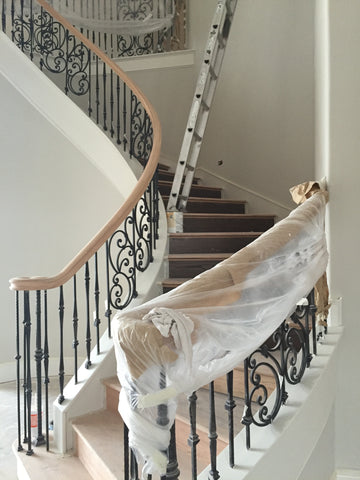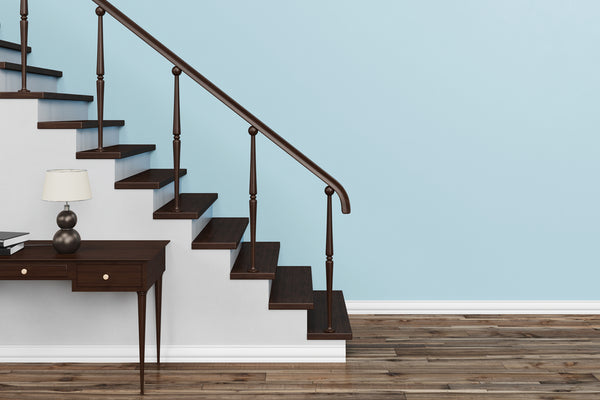Wrought Iron Stair Baluster Installation is Easy!!!
Preparation is Key!

Preparing your stairs for wrought iron baluster installation is easy. The purpose of this step is to protect the rest of your stairs as well as your furniture. Stair installations will be much smoother without the furniture and wall repairs later.
-
Cover any nearby furniture with 3mil plastic sheathing.
-
Remove anything from the walls adjacent to stairs so that they are not accidentally knocked off.
-
Prepare your workspace and needed tools. Tools you will need include :
-
Utility knife, pry bar, Saws All, Band Saw, Sander or Sand Paper, Drill and bits, Tape measure, Level, Balusters, Newel posts (if replacing), Handrail (if replacing), Fittings, Hardware, Screws, Stain, Paint, Polyurethane, Finishing nails (for wood).
-
Blog Post for this month:
When discussing stair installations with both your salesperson and installer, it is important to be on the same page in regards to the terminology involved. Don’t worry, though, this is very easy. There are only a few you need to worry about. Here is your primer on Stair Parts and Stair Installation terminology.
Stair Parts Glossary:
Baluster/Spindle - the vertical member, plain or decorative,
that acts as the infill between the handrail and baserail.
Balustrading - the collective name for the complete assembly
of handrails, baserails, newels, spindles and caps.
Bullnose Step - usually at the bottom of the stairs with one or
both ends of the step having a quarter circle design.
Closed String - a string with the face housed/trenched to
accommodate treads and risers so their profile cannot be seen.
Continuous Handrail - using straight lengths of handrail
connected to handrail fittings and ramps, the handrail flows over
the tops of newel turnings creating a continuous run of handrail.
Cut or Open String - a string with the upper edge cut away
to the shape of the treads and risers so that their profile can be
seen from the side.
Going - the going of a flight of stairs is the horizontal distance
between the face of the first and last risers. The individual
going of a step is measured from face of riser to face of riser
Newel - accommodates the balusters, handrails and treads/risers.
Nosing - the edge of the tread projecting beyond the face of
the riser and the face of a cut string.
Pitch - the angle between the pitch line and the horizontal.
Pitch Line - the notional line connecting the nosings of all
treads in a flight of stairs.
Rake - the pitch of the stairs.
Rise - the rise of a flight is the vertical distance between the
floors or landings connected by the flight. The individual rise is
the vertical measurement from top of tread to top of tread.
Riser - the board that forms the face of the step.
Staircase - the entire structure relating to a stair, comprising
steps, treads, risers, strings, balustrading, balusters, landings etc.
Stairway/Stairwell - the space/void provided for the stairs.
Step - the tread and riser combined.
String Margin - the distance between the top of the string
and the pitch line measured at 90° to the pitch line.
Tread - the top or horizontal surface of a step.
Wall String - the string of a staircase fixed flush with a wall.
Winders - are radiating steps narrower at one end that are
used to change the direction of a stairs through 90° or 180°.
Product Showcase:
Box Newel
Want to make a grand entrance to your home? The box newel is the perfect choice. It comes in flat panel, raised panel, recessed panel, and fluted to fit a variety of decors. From the 4” wide to 7 ½” wide a box newel will fit any application. A box newel will also help separate you from your neighbors and is the fastest growing newel style. Inquire about box newels today (make hot the last statement to a link to box newels landing page).
Money Saving Idea:
Want the look of hardwood treads with a carpet runner but don’t want to spend the high dollars on a full tread installation? Then look at the 8071/8072 false treads and risers in Red Oak. They go where your existing paint grade cap and rise are and give you the look of full treads and carpet runner at about half the price, saving you $1,500 to $2,00.00 on parts and installation. And they are a snap to install, many times going right back in place of your existing cap and rise with minimal cutting and fitting.
Specials:
Maple Box Newels, 7 in stock for 75% off, sale price is $65.00 each
What To Buy Guide:
When ordering parts, make sure you have all you need to complete your installation.
When purchasing balusters, you will need the balusters, base shoes (flat for balconies open stringer rakes, and angled for closed stringer rakes), under mount shoes (optional, flat shoes for balconies and angled shoes for rakes, make sure they have a set screw). You will also need epoxy and an epoxy gun to glue them in.
When purchasing handrail, please be sure if you are attempting to match any existing rail or fittings that you know the profile and dimensions of your current system. Also, when buying all new, be sure that your fitting profiles match the handrail profile designations. All of our descriptions and photo guides with help you with this. You will need rail bolts (typically included with fittings), wood glue and clamps to complete installation. Installation guides and templates are also normally included with the fittings.
When purchasing newels, you will need to know if you want to go with a post to post system or over the post system. With post to post systems you will need to buy a long face newel for landings and short face newels for starting sections and balcony intermediates. If you want to use all short face newels then you will need to utilize goosenecks for the landing to rake transitions. You will need sure-tite newel fasteners to anchor the newels. On post to post systems be sure to order the appropriate fittings to complete the installation.
When purchasing treads, measure from the wall to the outside of the stairs and order at least two inched longer to ensure proper trim and fit. On stairs that are open both sides, you will order a plain bullnose tread 2” deeper and 4” longer than the outside to outside measurement, and the returns will be done on site from the additional wood at the back of the tread. Liquid nails should be used in lieu of nails for a cleaner installation. Many types of mouldings are available to trim out your installation, but will be required for covering joints. Riser material can be cut from MDF, Oak, or Plywood depending on if you want stain or paint grade installation.
- Bill Vickers





